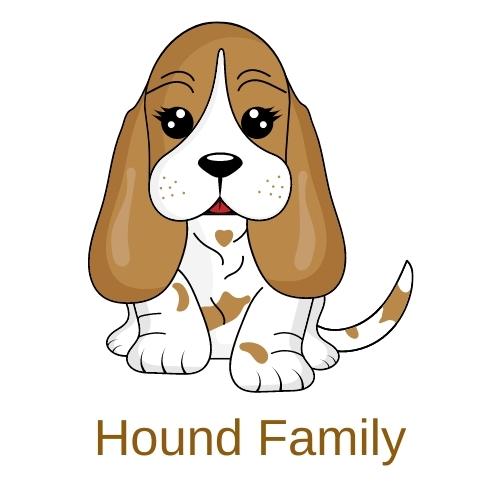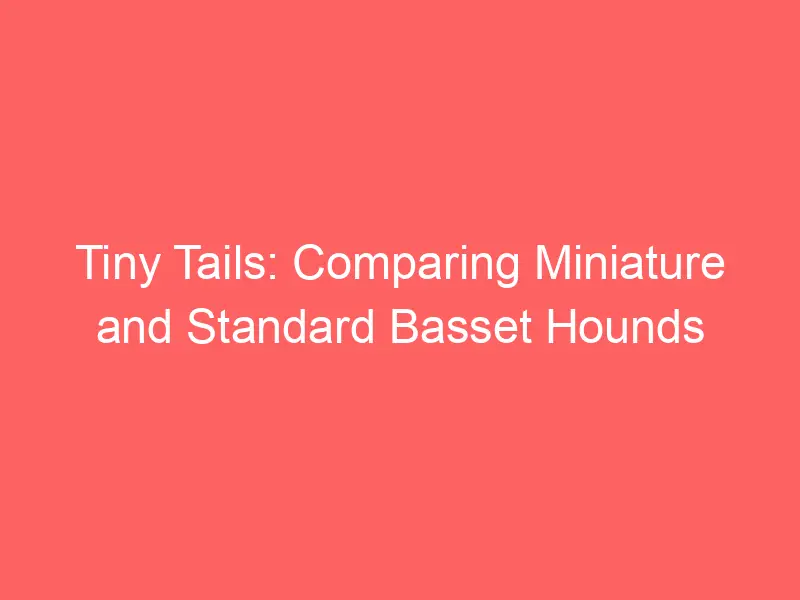
Introduction to Basset Hounds
Welcome to our comprehensive guide about Basset Hounds. This breed is known for its distinctive appearance and friendly nature. In this section, we will provide an overview of the breed and delve into its fascinating history.
- Overview of the Basset Hound breed
- History and origin of Basset Hounds
The Basset Hound is a short-legged breed of dog in the hound family. They are recognized by their long, droopy ears and wrinkled skin, which give them a unique, charming look. Basset Hounds are medium-sized dogs, typically weighing between 40 and 65 pounds. They are known for their keen sense of smell, which is second only to the Bloodhound.
Basset Hounds are also famous for their gentle, friendly, and patient nature. They are excellent with children and other pets, making them a great choice for families. However, they can be stubborn at times, so they require consistent training from a young age.
The Basset Hound breed originated in France in the 1500s. The word ‘Basset’ comes from the French word ‘bas’, which means ‘low’. This refers to the breed’s short stature.
The breed was developed for hunting small game, such as rabbits and hares. Their excellent sense of smell and short legs, which allow them to move slowly but steadily, made them excellent hunting dogs. They could follow a scent trail for hours without tiring.
Basset Hounds were brought to the United States in the late 1800s. They quickly gained popularity, both as hunting dogs and family pets. Today, Basset Hounds are loved by many for their unique appearance and friendly nature.
In the following sections, we will delve deeper into the variations within the Basset Hound breed, including size variations and breed variations. We will also provide case studies to help you understand these variations better. So, let’s continue our journey into the world of Basset Hounds!
Understanding Basset Hound Size Variations
When it comes to Basset Hounds, size is a significant factor that differentiates one dog from another. This breed comes in two main sizes: Standard Bassets and Miniature Basset Hounds. Let’s delve into a deeper understanding of these size variations.
Basset Hound Breed Sizes
-
Standard Bassets
Standard Bassets are the larger of the two types, typically weighing between 50 to 65 pounds. They stand at a height of about 14 inches at the shoulder. These dogs are known for their long, droopy ears and short, sturdy legs. They are also recognized for their keen sense of smell, second only to the Bloodhound. Despite their size, Standard Bassets are incredibly friendly and make excellent family pets.
-
Miniature Basset Hounds
On the other hand, Miniature Basset Hounds are smaller versions of the standard breed. They typically weigh between 30 to 35 pounds and stand about 10 to 12 inches tall at the shoulder. Miniature Bassets share the same physical characteristics as their larger counterparts, including the long ears and short legs. They are equally friendly and make great companions for those living in smaller spaces.
In conclusion, whether you choose a Standard Basset or a Miniature Basset Hound, you’re sure to have a loyal and loving companion. The size difference mainly affects the dog’s physical appearance and space requirements. Regardless of size, all Basset Hounds require regular exercise, a balanced diet, and lots of love and attention.
Size Difference in Basset Hounds
When it comes to Basset Hounds, one of the most noticeable characteristics is their size. However, not all Basset Hounds are the same size. There are significant differences that can be observed. Let’s delve into the size variations among Basset Hounds and the factors that influence their size.
- Comparing Basset Hound sizes
- Factors affecting Basset Hound size
There are two main types of Basset Hounds – the Standard Basset Hound and the Miniature Basset Hound. The Standard Basset Hound is larger, typically weighing between 50 and 65 pounds, and standing about 12 to 15 inches tall at the shoulder. On the other hand, the Miniature Basset Hound is smaller, usually weighing between 30 and 35 pounds, and standing about 10 to 12 inches tall at the shoulder.
| Type of Basset Hound | Weight | Height |
|---|---|---|
| Standard Basset Hound | 50-65 pounds | 12-15 inches |
| Miniature Basset Hound | 30-35 pounds | 10-12 inches |
Several factors can affect the size of a Basset Hound. These include genetics, diet, exercise, and overall health. Genetics plays a significant role, as the size of a Basset Hound’s parents can influence the size of the offspring. A balanced diet and regular exercise are also crucial for a Basset Hound’s growth and development. Lastly, a Basset Hound’s overall health can impact its size. For instance, a Basset Hound with health issues may not grow as large as a healthy one.
Miniature vs Standard Bassets
When it comes to Basset Hounds, size does matter. There are two main types: Miniature and Standard Bassets. Each has its unique characteristics that make them special. Let’s dive into the world of Miniature Bassets first.
Mini Basset Hound Characteristics
Mini Basset Hounds, as the name suggests, are a smaller version of the standard Basset Hound. They are known for their adorable size and distinctive traits. Let’s explore their physical and behavioral characteristics.
- Physical traits of Miniature Bassets
- Behavioral traits of Miniature Bassets
Mini Bassets are compact and weigh between 10 to 35 pounds. They stand about 8 to 14 inches tall at the shoulder. Their ears are long, and their eyes are droopy, giving them a sad but cute expression. They have a short, dense coat that comes in a variety of colors, including tri-color, black and white, and lemon and white.
Despite their small size, Mini Bassets have a big personality. They are known for their friendly and outgoing nature. They get along well with children and other pets, making them an excellent choice for families. However, they can be stubborn at times and require consistent training. They are also known for their keen sense of smell, second only to the Bloodhound.
In conclusion, Miniature Bassets are a bundle of joy packed in a small package. Their adorable size and friendly nature make them a favorite among dog lovers. However, their stubbornness can be a challenge and requires patience and consistent training.
Standard Basset Traits
Standard Basset Hounds are a unique breed with distinct physical and behavioral traits that set them apart. Let’s delve into these characteristics to better understand these adorable dogs.
- Physical traits of Standard Bassets
- Behavioral traits of Standard Bassets
Standard Basset Hounds are known for their long, droopy ears and short legs. They have a muscular build and a deep chest that houses their large lungs, a feature that enhances their scenting capabilities. On average, they weigh between 50 to 65 pounds and stand 12 to 15 inches tall at the shoulder. Their coat is short, dense, and comes in a variety of colors, including tri-color, bi-color, and single color.
Standard Basset Hounds are known for their calm and friendly demeanor. They are extremely loyal and form strong bonds with their families. Despite their somewhat lazy appearance, Bassets are quite playful and enjoy participating in family activities. They are also known for their stubbornness, which can sometimes make training a bit of a challenge. However, with patience and consistency, they can be trained effectively. Bassets are also known for their excellent sense of smell, which is second only to the Bloodhound.
Here is a quick summary of the Standard Basset Hound traits:
| Traits | Description |
|---|---|
| Physical Traits | Long ears, short legs, muscular build, deep chest, 50-65 pounds, 12-15 inches tall, short and dense coat |
| Behavioral Traits | Calm, friendly, loyal, playful, stubborn, excellent sense of smell |
Understanding these traits can help potential owners decide if a Standard Basset Hound would be a good fit for their family. Remember, every dog is unique and may not exhibit all the typical traits of their breed.
Basset Hound Breed Variations
When it comes to Basset Hounds, one of the most fascinating aspects is the variety within the breed. These variations are not just about size or color, but also about their genetic makeup. Let’s delve deeper into the world of Basset Hound breed variations.
Genetics of Basset Hound Breed Variations
Genetics play a significant role in the variations we see in Basset Hounds. The breed’s genetic diversity is influenced by several factors, which we will discuss in detail.
- Genetic factors influencing breed variations
- Health implications of breed variations
Genetic variations in Basset Hounds are primarily due to the combination of genes they inherit from their parents. These genes determine everything from their coat color to their size and even their temperament. For instance, if a Basset Hound inherits the gene for long ears from both parents, it will have longer ears than a Basset Hound that only inherited the gene from one parent.
Genetic variations can also have health implications. Some Basset Hounds may be genetically predisposed to certain health conditions. For example, Basset Hounds with a certain gene variation may be more prone to hip dysplasia, a common health issue in this breed. It’s important for potential owners to be aware of these health implications when choosing a Basset Hound.
In conclusion, understanding the genetics behind Basset Hound breed variations can help potential owners make informed decisions about the right Basset Hound for their family. It’s always a good idea to discuss these factors with a reputable breeder or a veterinarian to ensure you’re getting a healthy and happy dog.
Case Studies: Miniature and Standard Basset Hounds
Let’s delve into the daily lives of both Miniature and Standard Basset Hounds. This will give us a clearer picture of their unique characteristics and behaviors.
-
Case Study 1: A Day in the Life of a Miniature Basset Hound
Meet Max, a Miniature Basset Hound. Despite his smaller size, Max is full of energy and loves to play. His day starts with a brisk walk around the neighborhood, followed by a hearty breakfast. Max’s owners have noticed that he is more agile and quicker than his standard-sized counterparts.
Throughout the day, Max enjoys playing with his toys and exploring the house. He is also quite intelligent, quickly learning new commands and tricks. Despite his energetic nature, Max also enjoys his nap times and can often be found curled up in a sunny spot in the house.
Max’s smaller size makes him a perfect fit for apartment living. He is also less prone to certain health issues that affect larger Basset Hounds, such as hip dysplasia. However, he still requires regular exercise and mental stimulation to stay happy and healthy.
-
Case Study 2: A Day in the Life of a Standard Basset Hound
Now, let’s meet Bella, a Standard Basset Hound. Bella’s day is a bit more laid-back compared to Max’s. She enjoys a leisurely walk in the morning, followed by a good meal. Bella is known for her calm and patient demeanor, making her a great companion for families with children.
Bella spends her day lounging around the house, always ready for a belly rub or a treat. She is also quite the sniffer, often following her nose around the house or yard. Despite her slower pace, Bella still enjoys playtime and can be quite playful when the mood strikes.
Being a larger dog, Bella requires more space and is better suited for a house with a yard. She is also more prone to certain health issues, such as obesity and ear infections, so her owners need to be vigilant about her diet and grooming.
As you can see, both Miniature and Standard Basset Hounds have their unique traits and characteristics. Whether you choose a Miniature or Standard Basset Hound, you’ll be gaining a loyal and loving companion.
Conclusion: Choosing Between Miniature and Standard Basset Hounds
As we conclude, it’s important to remember that choosing between a miniature and standard Basset Hound is a decision that should be made with careful thought and consideration. Both variations of the breed have their unique characteristics and requirements. Let’s take a look at some key considerations and takeaways.
- Considerations when choosing a Basset Hound
- Key takeaways: Miniature vs Standard Bassets
When deciding on a Basset Hound, consider your living situation, lifestyle, and the amount of time you can dedicate to your pet. Basset Hounds, regardless of size, require regular exercise to maintain a healthy weight. They are also known for their strong sense of smell, so a secure yard is ideal.
Furthermore, Basset Hounds are social animals and thrive in a family environment. They need regular interaction and do not do well when left alone for extended periods. Lastly, consider potential health issues. Both miniature and standard Basset Hounds can be prone to certain health conditions, so regular vet check-ups are essential.
Miniature Basset Hounds are smaller in size, making them a good fit for those living in apartments or smaller homes. They are just as friendly and loyal as their standard counterparts but may be easier to manage due to their size.
Standard Basset Hounds, on the other hand, are larger and may require more space. They are known for their endurance and strength, making them great companions for those who enjoy outdoor activities. However, they may require more exercise to prevent obesity.
In conclusion, the choice between a miniature and standard Basset Hound ultimately depends on your personal circumstances and preferences. Both breeds have their unique charm and can make wonderful pets. The most important thing is to provide them with the love and care they deserve.








